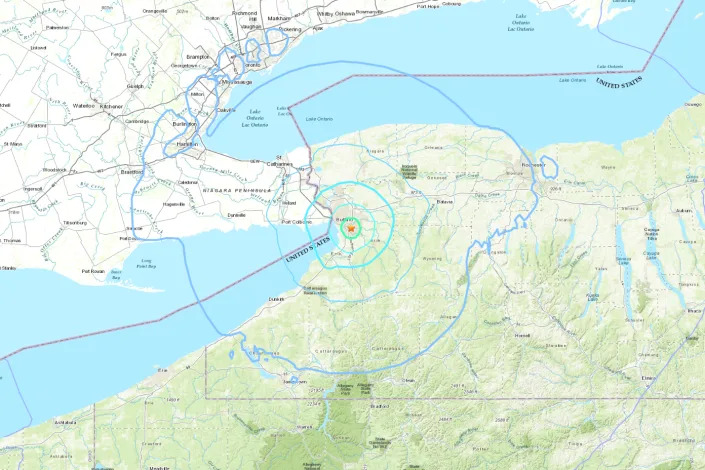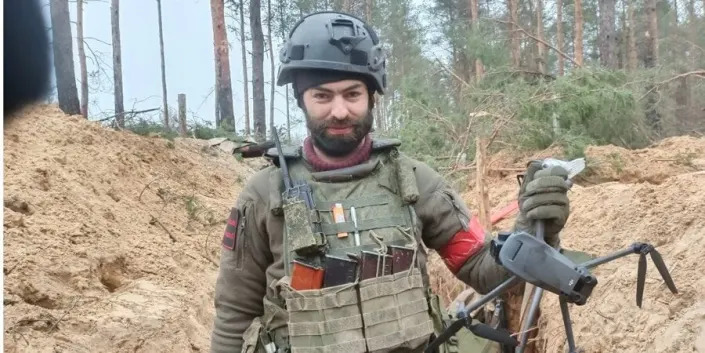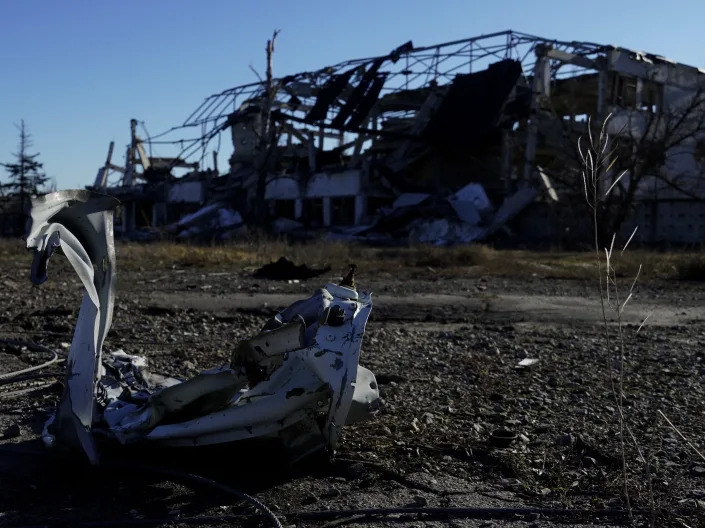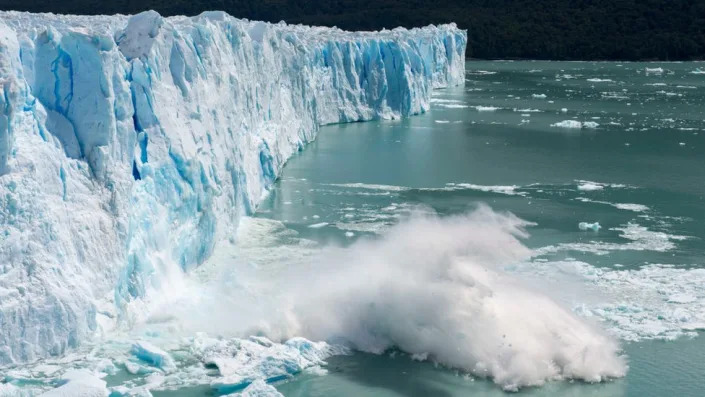Aditi Bharade
Tue, 7 February 2023
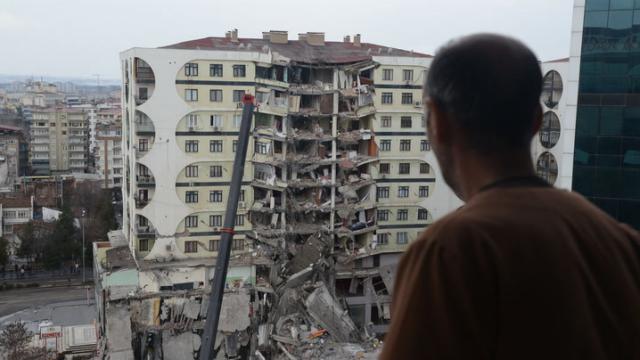
A journalist from Turkish media outlet A News was reporting live on earthquake rescue efforts.
His broadcast was interrupted by the onset of a second earthquake, per a video by The Telegraph.
The journalist ran towards a little girl, carried her to safety, and tried to calm her down.
A journalist abandoned his live broadcast while reporting on the devastating 7.8 magnitude earthquake in Turkey so he could carry a little girl to safety.
Yuksel Akalan, a journalist from the Turkish media outlet A News, was reporting on Monday on rescue efforts in the aftermath of the first earthquake. Akalan was filming with his cameraman on a street in Malatya, Turkey, per CBS News.
But Akalan's broadcast was cut short when he was caught in the middle of a powerful second earthquake, a video published by The Telegraph and Reuters showed. In the video, Akalan is seen running while the ground shakes. Sirens can be heard blaring in the background and structures can be heard crashing to the ground.
According to The Telegraph, Akalan said in the video: "As we were heading to the rubble to film search and rescue efforts, there were two consecutive aftershocks with a loud noise and the building you are seeing on my left was brought down to earth."
The video then cuts to the journalist running towards a young girl in distress, lifting her up and carrying her out into the open street.
After setting the crying girl down, Akalan is seen comforting her and telling her to remain calm, per The Telegraph's subtitles. He then resumed his broadcast.
—Reuters (@Reuters) February 6, 2023
The first quake was one of the strongest to hit the region in over 100 years.
The death toll from the quakes has exceeded 4,300 and is expected to rise, CNN reported.
Representatives for A News did not immediately respond to Insider's request for comment.
Aspen Pflughoeft
Mon, February 6, 2023
A powerful earthquake and numerous large aftershocks rocked southern Turkey and northern Syria throughout the day on Monday, Feb. 6. Videos showed the devastating scenes where thousands have been killed or injured.
The initial 7.8 magnitude earthquake struck near Nurdağı, Turkey, in the middle of the night on Feb. 6, according to the United States Geological Survey. A series of aftershocks — including a massive quake with a 7.5 magnitude — rocked the Gaziantep region for hours.
The earthquakes flattened buildings in southern Turkey and northern Syria. Videos shared on Facebook by India Today and RTE News showed multi-story buildings crumbling in seconds, filling the streets with dust and rubble.
Thousands of people have been killed or injured from the earthquakes, but the exact death toll remains unclear. CNN reported that “more than 1,500 people” were killed across both countries. The Associated Press reported that the earthquakes have killed “more than 2,300 people.” Rescue teams are searching to find survivors amid the rubble.
Cold winter weather in the region is complicating rescue efforts and further endangering trapped survivors, CNN reported. The weather could reduce the time rescuers have to find and save people trapped under the rubble.
The earthquakes were felt as far as Cairo, Egypt, and Beirut, Lebanon, The Associated Press reported.
A survivor in Atareb, Syria, told Reuters the earthquakes felt “like the apocalypse.”
Drone footage shared by The Daily Sabah, Anadolu Agency and Reuters showed scenes of devastation from multiple cities in Turkey.
Rescue and relief operations are underway in Turkey and Syria, The Associated Press reported.
A map from the U.S. Geological Survey shows where the earthquakes hit. Nurdağı is a city in the Turkish province of Gaziantep and about 610 miles southeast of Istanbul. The Gaziantep region is along the Turkey-Syria border.
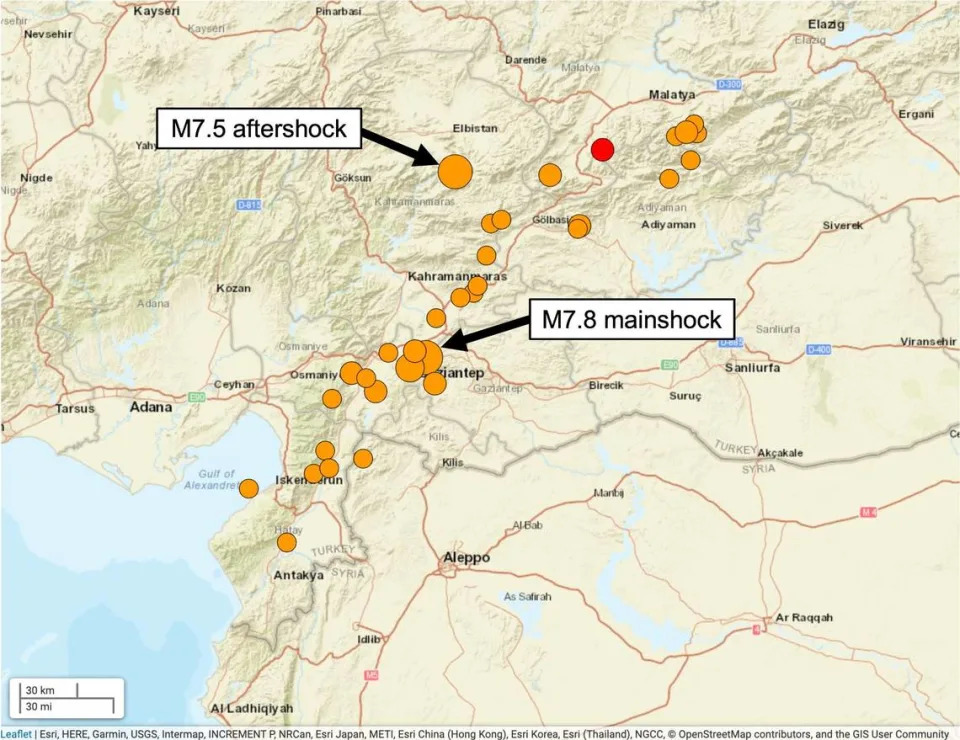
A map shows the location of the earthquake and aftershocks that rocked southern Turkey and northern Syria.
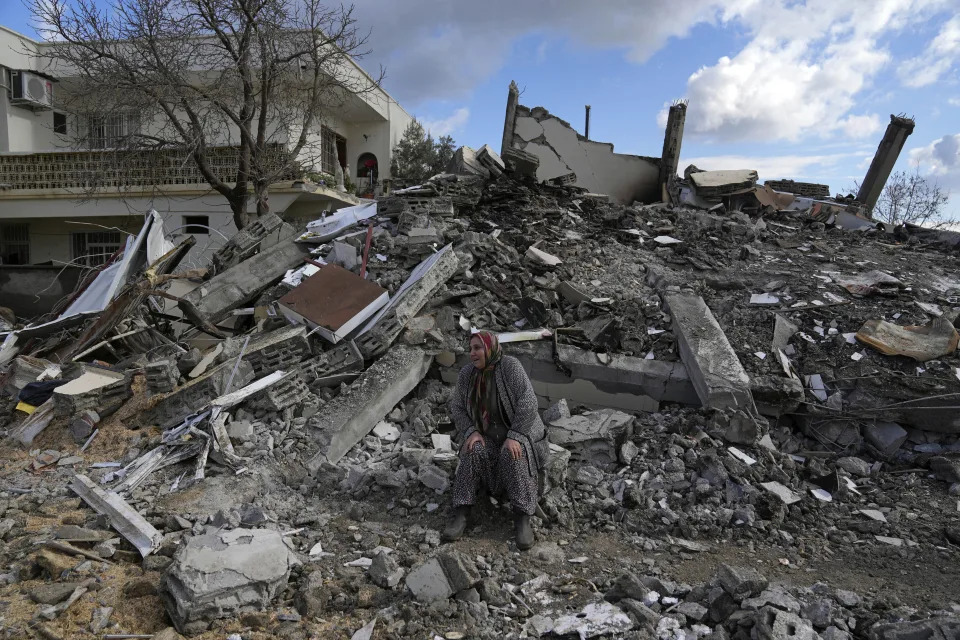
APTOPIX Turkey Earthquake
A woman sits on the rubble as emergency rescue teams search for people under the remains of destroyed buildings in Nurdagi town on the outskirts of Osmaniye city southern Turkey, Tuesday, Feb. 7, 2023. A powerful earthquake hit southeast Turkey and Syria early Monday, toppling hundreds of buildings and killing and injuring thousands of people. (AP Photo/Khalil Hamra)
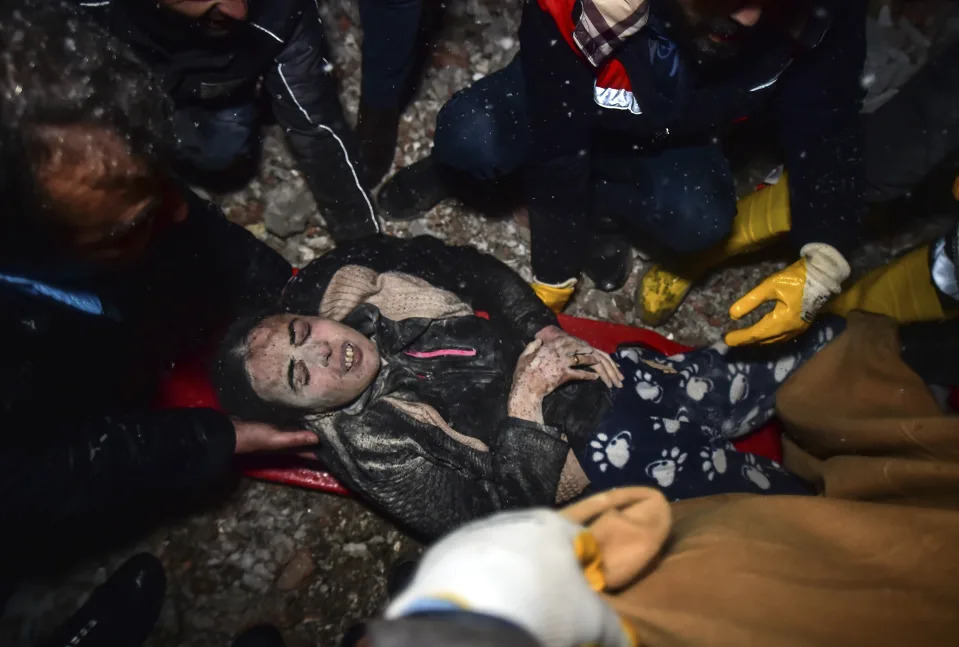
Rescue workers and medics carry a woman out of the debris of a collapsed building in Elbistan, Kahramanmaras, in southern Turkey, Tuesday, Feb. 7, 2023. Rescuers raced Tuesday to find survivors in the rubble of thousands of buildings brought down by a 7.8 magnitude earthquake and multiple aftershocks that struck eastern Turkey and neighboring Syria. (Ismail Coskun/IHA via AP)
APTOPIX Turkey Earthquake 2/14


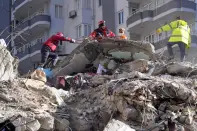
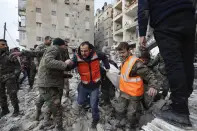
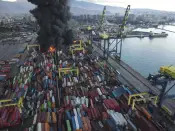
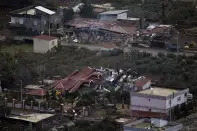

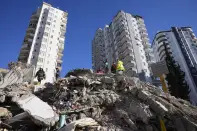
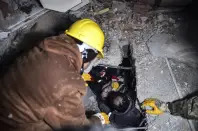
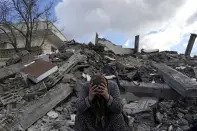
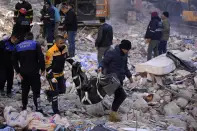
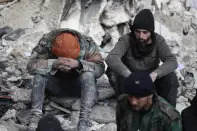

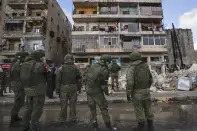
MEHMET GUZEL, GHAITH ALSAYED and SUZAN FRASER
Mon, February 6, 2023
NURDAGI, Turkey (AP) — Search teams and emergency aid from around the world poured into Turkey and Syria on Tuesday as rescuers working in freezing temperatures dug — sometimes with their bare hands — through the remains of buildings flattened by a magnitude 7.8 earthquake. The death toll soared above 5,000 and was still expected to rise.
But with the damage spread over a wide area, the massive relief operation often struggled to reach devastated towns, and voices that had been crying out from the rubble fell silent.
“We could hear their voices, they were calling for help," said Ali Silo, whose two relatives could not be saved in the Turkish town of Nurdagi.
In the end, it was left to Silo, a Syrian who arrived from Hama a decade ago, and other residents to recover the bodies and those of two other victims.
Monday's quake cut a swath of destruction that stretched hundreds of kilometers (miles) across southeastern Turkey and neighboring Syria, toppling thousands of buildings and heaping more misery on a region shaped by Syria’s 12-year civil war and refugee crisis.
Aftershocks then rattled tangled piles of metal and concrete, making the search efforts perilous, while freezing temperatures made them ever more urgent.
The scale of the suffering — and the accompanying rescue effort — were staggering.
More than 8,000 people have been pulled from the debris in Turkey alone, and some 380,000 have taken refuge in government shelters or hotels, said Turkish Vice President Fuat Oktay. They huddled in shopping malls, stadiums, mosques and community centers, while others spent the night outside in blankets gathering around fires.
Many took to social media to plead for assistance for loved ones believed to be trapped under the rubble — and Turkey's state-run Anadolu Agency quoted Interior Ministry officials as saying all calls were being “collected meticulously” and the information relayed to search teams.
Turkish President Recep Tayyip Erdogan said 13 million of the country's 85 million were affected in some way — and declared a state of emergency in 10 provinces in order to manage the response.
For the entire quake-hit area, that number could be as high as 23 million people, according to Adelheid Marschang, a senior emergencies officer with the World Health Organization.
“This is a crisis on top of multiple crises in the affected region,” Marschang said in Geneva.
Teams from nearly 30 countries around the world headed for Turkey or Syria.
As promises of help flooded in, Turkey said it would only allow vehicles carrying aid to enter the worst-hit provinces of Kahramanmaras, Adiyaman and Hatay in order to speed the effort.
The United Nations said it was “exploring all avenues” to get supplies to rebel-held northwestern Syria, where millions live in extreme poverty and rely on humanitarian aid to survive.
Nurgul Atay told The Associated Press she could hear her mother's voice beneath the rubble of a collapsed building in the Turkish city of Antakya, the capital of Hatay province, but that her and others' efforts to get into the ruins had been futile without any heavy equipment to help.
“If only we could lift the concrete slab we'd be able to reach her,” she said. “My mother is 70 years old, she won't be able to withstand this for long.”
But in the northwestern Syrian town of Jinderis, a young girl called Nour was pulled alive from the wreckage of a collapsed building Monday.
A rescuer cradled her head in his hands and tenderly wiped dust from around her eyes as she lay amid crushed concrete and twisted metal before being pulled out and passed to another man.
Turkey has large numbers of troops in the border region with Syria and has tasked the military to aid in the rescue efforts, including setting up tents for the homeless and a field hospital in Hatay province. Defense Minister Hulusi Akar said a humanitarian aid brigade based in Ankara and eight military search and rescue teams had also been deployed.
A navy ship docked on Tuesday at the province’s port of Iskenderun, where a hospital collapsed, to transport survivors in need of medical care to a nearby city. Thick, black smoke rose from another area of the port, where firefighters have not yet been able to douse a fire that broke out among shipping containers toppled by the earthquake.
In northern Syria, meanwhile, Sebastien Gay, the head of mission in the country for Doctors Without Borders, said health facilities were overwhelmed with medical personnel working around “around the clock to respond to the huge numbers of wounded.”
The affected area in Syria is divided between government-controlled territory and the country’s last opposition-held enclave, which is surrounded by Russian-backed government forces. Turkey is home to millions of refugees from the Syrian civil war.
The rebel-held enclave is packed with some 4 million people displaced from other parts of the country by the war. Many live in buildings that were already damaged by military bombardments.
Erdogan said the total number of deaths in Turkey had passed 3,500, with some 22,000 people injured.
The death toll in government-held areas of Syria climbed over 800, with some 1,400 injured, according to the Health Ministry. The country’s rebel-held northwest also saw at least 800 die, according to the White Helmets, the emergency organization leading rescue operations, with more than 2,200 injured.
The region sits on top of major fault lines and is frequently shaken by earthquakes. Some 18,000 were killed in similarly powerful earthquakes that hit northwest Turkey in 1999.
The U.S. Geological Survey measured Monday’s quake at 7.8, with a depth of 18 kilometers (11 miles). Hours later, another quake, likely triggered by the first, struck more than 100 kilometers (60 miles) away with 7.5 magnitude.
Alsayed reported from Azmarin, Syria, while Fraser reported from Ankara, Turkey. Associated Press writers David Rising in Bangkok, Zeynep Bilginsoy and Robert Badendieck in Istanbul, Bassem Mroue and Kareem Chehayeb in Beirut, Kim Tong-hyung in Seoul, South Korea, and Riazat Butt in Islamabad, contributed to this report.

